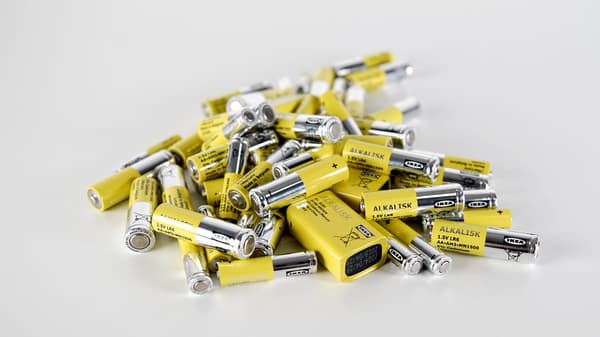IKEA to remove non-rechargeable alkaline batteries by October 2021

Inspiring and enabling customers to live a more sustainable everyday life at home
“We are pleased to be phasing out ALKALISK alkaline batteries from the range globally and increasing thefocus on our rechargeable batteries,” says Lars Svensson, the Sustainability Director for IKEA Southeast Asia& Mexico. “We hope this enables the many in Southeast Asia to opt for an affordable and convenientrechargeable battery, prolonging the life of products and materials while also reducing waste and savingmoney.’’
The IKEA range of LADDA batteries can be charged up to 500 times and are nickel metal hydride (NiMH).Several current comparative Life Cycle Assessment studies show that rechargeable NiMH batteries have less environmental impact than alkaline batteries when used in high-energy-consuming devices that arecharged on a regular basis - such as toys, flashlights, portable speakers or cameras.1
Already after 10 charges, a rechargeable NiHM battery such as the LADDA range sold in IKEA stores, emitslower greenhouse gas than alkaline batteries do when obtaining the same amount of energy. After about50 charges, the overall environmental impacts2 of NiMH batteries is equal or less than the impact of usingalkaline batteries.3
“There are substantial savings to be made over time – on the environment as well as our wallets – when weadopt new behaviours and use rechargeable batteries to their full potential,” says Mr. Svensson. “And thisalso helps reduce waste.”
IKEA globally sold about 300 million alkaline batteries last year and, within the nine IKEA stores operated in Singapore, Malaysia and Thailand, customers bought some 3.4 million packs of non-rechargeable ALKALISK batteries. Hypothetically, if all IKEA customers switched from ALKALISK alkaline batteries to LADDA rechargeable batteries for high-drain devices (and charged them just 50 times), together we would reduceglobal waste by as much as 5,000 tons a year.4
ALKALISK batteries will be phased out over time, providing suppliers time to adjust and allowing IKEAretailers to sell current stocks. The phase out is to be completed worldwide by October 2021. At this point,the lithium ion button cell battery called PLATTBOJ will be kept in the range as some applications currentlybeing sold by IKEA require a button cell battery to function
1 Comparative Life cycle analysis of alkaline batteries against rechargeable NiMH batteries. Dolci et al., 2016; Mahmud, 2019; Parsons, 2007, and Menet and Gruescu, 2013.
2 Climate change, acidification, eutrophication (terrestrial, freshwater, and marine), freshwater ecotoxicity, human toxicity (cancer effects and noncancer effects), particulate matter, water resourcedepletion, and mineral and fossil resource depletion)
3 Comparative Life cycle analysis of alkaline batteries against rechargeable NiMH batteries. Dolci et al., 2016; Mahmud, 2019; Parsons, 2007, and and Gruescu, 2013.
4 Calculations are based on the comparative LCA studies listed in footnote 1, extrapolated to LADDA and ALKALISK batteries, based on FY19 sales figures of LADDA and assuming all LADDA batteries arecharged 50 times according to IEC 61951-2 Ed.3 (2011) standards and in high-drain devices.
Sources - Comparative Life Cycle Assessment studies of alkaline batteries against rechargeable NiMHbatteries:
- Dolci, G., Tua, C., Grosso, M. and Rigamonti, L., 2016. Life cycle assessment of consumption choices: acomparison between disposable and rechargeable household batteries. The International Journal of LifeCycle Assessment, 21(12), pp.1691-1705.
- Mahmud, M.A., Huda, N., Farjana, S.H. and Lang, C., 2019. Comparative life cycle environmental impactanalysis of lithium-ion (LiIo) and nickel-metal hydride (NiMH) batteries. Batteries, 5(1), p.22.
- Parsons, D., 2007. The environmental impact of disposable versus re-chargeable batteries for consumeruse. The International Journal of Life Cycle Assessment, 12(3), p.197.
- Menet, J.L. and Gruescu, I.C., 2013, November. Comparative Life Cycle Assessment Of Alcaline Cells AndNi-Mh Rechargeable Batteries